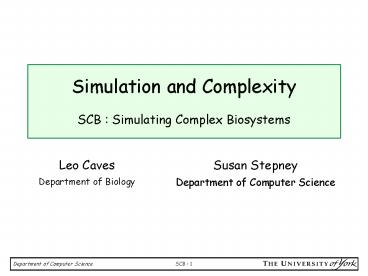Simulation and Complexity SCB : Simulating Complex Biosystems - PowerPoint PPT Presentation
1 / 13
Title:
Simulation and Complexity SCB : Simulating Complex Biosystems
Description:
to introduce the methods, applications and practical issues associated with the ... http://algorithmicbotany.org/vmm-deluxe/Section-09.html. subapical growth in ... – PowerPoint PPT presentation
Number of Views:120
Avg rating:3.0/5.0
Title: Simulation and Complexity SCB : Simulating Complex Biosystems
1
Simulation and ComplexitySCB Simulating
Complex Biosystems
- Susan Stepney
- Department of Computer Science
Leo Caves Department of Biology
2
Module Aims
- to provide an introduction to the structure,
organisation and properties of biosystems and
their analysis from the perspective of complex
systems (e.g. self-organisation, emergence) - to introduce the methods, applications and
practical issues associated with the computer
simulation of biosystems - to explore the potential applications of such a
systems approach to biology in medicine and
engineering
3
Systems biology
- An approach to Biology focusing on the
integration of existing biological knowledge
towards building predictive models of biological
systems. - a systems view, rather than a component view
- structure (anatomy components and interactions)
- dynamics (physiology)
- control mechanisms
- design methods
- a model-based view, rather than a descriptive view
4
biological models languages and tools
- enormous amounts of data
- modelling at different biological levels
- metabolic networks, cell, organs, organisms,
populations, - biology-specific tools
- gene ontology a structured vocabulary
- systems biology markup language (SBML)
- generic tools
- mathematics
- differential equations, difference equations,
fractals, - computer modelling languages
- UML, petri nets,
5
modelling and simulation
analysis(eg solving the equations)
the model (eg mathematical equations)
the solution (consequences of the model)
the easy bit !
formal
deducing the consequences (concept mapping)
modelling the world(concept mapping)
informal
the difficult bit !
the domain (the real world)
the prediction (real world consequences)
update, refine, and iterate if the model and
reality disagree, it is the model that is wrong
6
modelling proteins
- based on the protein sequence
- what does it interact with?
- based on various inference methods / correlations
- what is the structure?
- thermodynamic methods
- simulations
- based on the structure
- what does it interact with?
- hybrid methods
- combining data, statistics, models,
7
modelling networks
- networks everywhere
- regulatory networks
- metabolic networks
- signalling networks
- connectivity and topology
- random
- hierarchical
- scale free, small world,
- robust yet fragile
- motifs, modules,
8
reaction-diffusion equations
- non-linear f and g, coupled
- reaction rates, dependent on c1 and c2
- spatial patterns
- if different diffusion rates k1 ? k2
- local activation long range inhibition
- animal coat patterns Alan Turing 1952
9
Petri net example Fas-induced apoptosis
- Matsuno et al, 2003
as a cartoon
as a Petri Net
10
state chart example immune system model
Kam, Cohen, Harel. The Immune System as a
Reactive System.
11
L-systems modelling plant morphology
subapical growth in Capsella bursa-pastoris
three signals used in Mycelis muralis
http//algorithmicbotany.org/vmm-deluxe/Section-09
.html
12
Sydney Brenners questions
- the process of life may be described in the
dynamical terms of trajectories, attractors, and
phase spaces - how does the egg form the organism?
- developmental trajectory to an attractor in the
phase space of the organism ? - how does a wounded organism regenerate exactly
the same structure as before? - injury as a small perturbation from the attractor
in the phase space of the organism ?
13
hierarchies of emergence
- life emerges from matter with structure and
dynamics - life as a structured, dynamical process (and not
as a thing)































